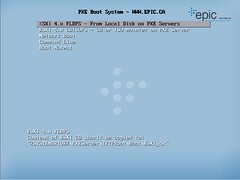Problem
When trying to Power On an old VM I was greeted with this message:

I checked the Datastore and everything seemed to be present and correct. I tried to migrate the VM to a different Host, but again I was shown this error. A quick Google didn't show up anything useful so I decided to check the logs.
running the command tail /var/log/vmware/hostd.log -f whist trying to Power On the VM flagged these error messages:
- [2010-03-24 12:11:10.547 'BaseLibs' 129907632 info] readlink /var/run/vmware/7f0f49adb5092b09694cdf456a488d6c: No such file or directory
- [2010-03-24 12:11:10.547 'BaseLibs' 129907632 info] readlink /var/run/vmware/%2fvmfs%2fvolumes%2f4ad45c8d%2ddb2eadd5%2d411f%2d00237d3c8b86%2fTEST%2dVWB01%2fTEST%2dVWB01%2evmx: No such file or directory
Solution
Read the rest of this entry »

Just a quick post about using ESXTOP with VMware ESXi. Obviously in ESXi there is no Service Console so we have to use the vMA (vSphere Management Assistant) to help us. If you haven't installed the vMA on your infrastructure yet, you can download it here: http://www.vmware.com/support/developer/vima/
Once install and configured, login and run the following command: resxtop –server <server name>
You will be prompted to login, use the root user/pass of the Host you want to run ESXTOP on (Note: Logging in as root will not work if the Host is in "Lockdown Mode".). You should then be presented with ESXTOP, I believe it has all of the same function as it did in the Service Console
Here you can see all avaliable options when connecting to a Host using RESXTOP
usage: resxtop [-h] [-v] [-b] [-s] [-a] [-c config file] [-d delay] [-n iterations]
[--server server-name [--vihost host-name]] [--portnumber socket-port] [--username user-name]
-h prints this help menu.
-v prints version.
-b enables batch mode.
-s enables secure mode.
-a show all statistics.
-c sets the esxtop configuration file, which by default is .esxtop4rc
-d sets the delay between updates in seconds.
-n runs resxtop for only n iterations.
--server remote server name.
--vihost esx host name, if --server specifies vc server.
--portnumber socket port, default is 443.
--username user name on the remote server.
for more information on interactive and batch modes
please see man page for resxtop.

Why, oh why, oh why, has every man and his dog started calling everything Cloud? Cloud Hosting, Cloud Apps, Cloud Services? Is it me, or was it only 6 months ago that these were called Virtual Hosting, Web Apps, Web Services? What's changed? In my eyes, nothing! I hadn't really noticed this until the other day when I was attending a "Cloud" seminar.
Cloud Hosting: What makes it Cloud? It's just Hosting on a Virtualization platform. Cloud Apps: Why are they Cloud Apps? They are just applications hosted over the Web, no? If we follow this trend we'll soon be calling WebMail, CloudMail!
Read the rest of this entry »
Introduction and Requirements– Part 1
Testing and Exporting to vSphere – Part 2
Customising the ESXi Rapid Deployment Server
I couldn't just stop there could I? I decided to make a few alterations to make it a little prettier and hopefully quicker.
Removing some ESXi installation steps which are not required
I'll start off by talking about making some changes to the ESXi installation to help make the deployment a little quicker. I got the idea from Stuart Radnidge's great post; Unattended ESXi Installation. Stu talks about editing one of the Python files that make-up the ESXi installation. Stu has a link to a pre-prepared Install.tgz for you to replace the default Install.tgz that comes in the ESXi ISO. Unfortunately this wouldn't work for me as I was using the ESXi ISO that comes with HP Management Agents so I had to make the changes myself:
Read the rest of this entry »
Introduction and Requirements – Part 1
Customising and Optimising – Part 3
Testing The PXE Boot System
Now that the PXE Server is configured I quickly made a VM in VMware Workstation to deploy ESXi to using the settings in a previous post I wrote.
Here are the steps and settings I used.
- Create a Virtual Machine, Custom
- Workstation 6.5-7.0 Hardware Compatibility
- VMware ESX, ESX Server 4.0
- Number of processors: 1
- Memory: 2048
- Host-Only Networking
- LSI Logic,
- New disc, SCSI
- 30GB, pre-allocated, single file
- Customise hardware, remove: soundcard, USB, floppy – Set execution mode to: IntelVT-x — Customise hardware, add: 5 x Network Adapter’s (Host-Only Networking)
- Edit .vmx and add the following
- ethernet0.virtualDev = “e1000”
- ethernet1.virtualDev = “e1000”
- monitor_control.restrict_backdoor = “true”
PXE Booting the ESXi ready VM displayed the default deployment menu that is shipped with the V-PXEServer application.

Read the rest of this entry »
Testing and Exporting to vSphere – Part 2
Customising and Optimising – Part 3
Introduction
With VMware ESXi looking to be the future of VMware's Hypervisors, we are seeing the end of our beloved Service Console. Like many others I've been beginning to look into how ESXi will be implemented into a Production environment. One of the main area's of interest for me was around setting up a system which would deploy ESXi Hosts.
In the past, when deploying ESX Hosts, I've had the assistance of EDA (ESX Deployment Application), others have also used UDA (Ultimate Deployment Appliance). But due to the absence of the Service Console, scripted installations using Kickstart scripts are now not possible with ESXi.
When looking for a new deployment system to deploy ESXi I was looking for the following requirements;
- Simple Setup – I don't have the time to spend days and days on configuring an application to deploy my Hosts
- Simple Deployment – I want the deployment procedure to be a simple as possible. The deployment of Hosts maybe passed to a team that aren't as accustomed to VMware as I am.
- Quick – I want the deployment of my ESXi Host to be quick, I don't want to have to wait an hour for a Host.
- FREE! – We all love free, espically my CEO.
Read the rest of this entry »

When trying to change the Preferred Path on Storage Adapter I was greeted with the following Error message
Unable to cast object of type ‘LogicalUnitPolicy’ to type ‘FixedLogicalUnitPolicy’
I checked my other Storage Adapters and these too gave me the same error.
The Fix
Read the rest of this entry »

Veeam have just released some White Papers all written by VMware vExperts. See Veeam's complete series of white papers here or click on our latest additions below.
5 Ways VMware vSphere Improves Backup and Recovery
by Eric Siebert, VMware vExpert, Senior systems administrator at Boston Market
“New VMware vSphere and its vStorage technology improve data protection and disaster recovery. The White Paper explains how organization of all sizes can reduce storage utilization by 30%, increase the full backup speed by 50% and incremental backup speed by 90%, lower the cost of near-CDP by 80% while increasing reliability.”
http://www.veeam.com/go/vmware-vsphere-backup-wp
Read the rest of this entry »

VMware Workstation 7 License Keys are on their way!! Yes it's true, I've just head from VMware and they have confirmed to me that they have just started emailing the keys out to all VCP4's. So keep an eye on your Inbox. Workstation is a brilliant application of which I use daily.
The message from VMware:
Any new certification gets a key, so even if you were a VCP3, your VCP4 is a NEW certification (for vSphere) and you get a key. The only people who will not receive a key is existing VCPs who are not obtaining a new certification.

To view a Video of the installtion process click Here or scroll to the bottom of the post.
Check for the latest version, VMware will tell you the latest version here: http://www.vmware.com/support/esx25/doc/sys_mgmt_links.html (v8.3.1 at the time of writing)
Download the latest HP Management Agents for VMware ESX Server 4.x
Read the rest of this entry »
![]()







